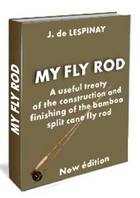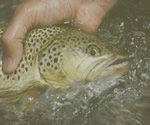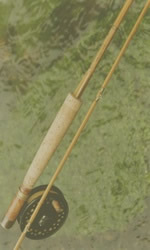Bamboo Fly Rod Building
Guides bamboo fly rods
Mounting the guides
THE TOP GUIDE
The guides still used on bamboo rods are made from a hard chromium plated tube, inside which are threaded the two feet of a sturdy metal ring.
The whole thing is soldered and chromium plated, giving a rather long guide (25 mm overall length with an 18 mm tube).
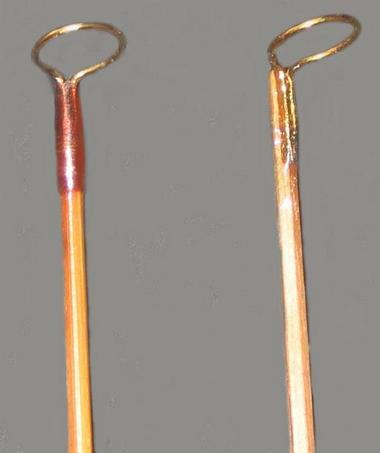
9.2 Single foot guide on a tip head.
See on the right
how it is attached with cyanoacrylate
glue before wraping
As the usable part inside which threads on to the tip head is only 13 mm long the tube is partly occupied by the steel feet of the wire forming the guide.
The set is quite heavy for a top guide (0.6 grams).
At present we tend to use a single foot guide for the tip head.
I find it perfect, especially for the very thin tips. (Photo 9.2).
Sometimes I file down the foot to reduce its width in order to fit the size of the tip. With a file, notch the face intended to receive the guide foot to avoid it protruding from the tip profile thus allowing the line to pass close to the rod curve.
The inner diameter of these guides is generally between 4 and 5 mm which is good for the rods measuring 2 to 3 metres.
One can use smaller sizes, especially when using natural or "intermediate" line as they have a smaller section than the "self floating" ones.
(…)
GUIDE SPACING
Some years ago, a distributor chain for fishing equipment issued a small article about rod dressing. It was a friendly initiative, despite the fact that almost half the paper was an anthology of the things to avoid, especially when it came to the guide spacing. This small paper actually gave the recommended guide spacing for some commercial rods, in order to help the amateur using those fibres. Once more a friendly initiative but there are two points to make.
(…)
Guide spacing method
Once they have determined the number of guides many builders advance by rough estimates, by adding x for each previous interval i. For example: x =2 centimetres, first interval (i-1) – 9 centimetres (TG to S1).
Second interval (i-2) = (i-1 + 2cm) = 11 centimetres (S1 to S2).
In practice this is never accurate; moreover this system is purely theoretical as it does take into account the curve of the rod and so it must be rejected.
There are only two methods that give good results, the first one being a making of the second.
Calculation formula
The values of i(i-1, i-2, i-3, etc...) are obtained from the following formula:
i= [L-(N x d1)]/K Were x is the distance to be added to the previous interval, L the distance from SG to the end of the tip (SG-TG), N the number of guides (S + SG), d1 the distance between the first guide S1 to TG, K a constant function of the number of guides.
NUMBER OF GUIDES A |
CALCULATION K |
VALUE OF K |
6 |
|
15 |
7 |
6 + 15 |
21 |
8 |
7 + 21 |
28 |
9 |
8 + 28 |
36 |
10 |
9 + 36 |
45 |
Etc... |
|
|
For example with L = 190 cm, A = 9 and first spacing i-1 = 10 cm
x = [190 – (9 x 10)] / 36 = 100 / 36 = 2.77 cm, which is the length to add to the previous interval. Which will give: i-1 = 10; i-2 = 12.77 (10 + 2.77); i-3 = 15.54 (12.77 + 2.77); i-4 = 18.31; etc.
While this method is precise and adjustable (by changing the value of i-1 everything is modified) there is another advantage as you can, at your will, start from any butt guide considered as SG. It is often useful if you want a better distribution around the tip-butt link.
The visual method
In the previous paragraph I told you that the first method was one approach that I will now describe.
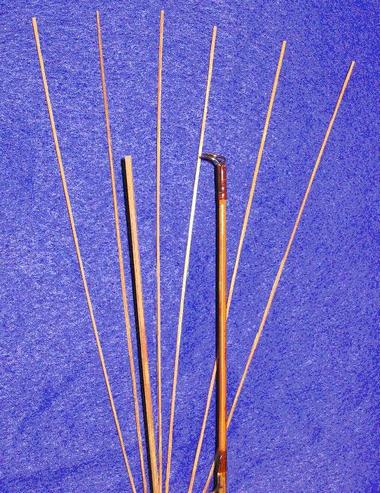
The formula method gives an even spacing of the guides.
But the passive curve of a rod shows that it is necessary to adapt the spacing to the flexing. Following the result given by the formula, you can temporarily attach the guides to the rod with adhesive tape.
Then block the rod at the hand grasp and attach a weight to a yarn going through all guides.
The best distribution is obtained when the angles formed between the yarn and the guides are identical.
It is often required to modify everything, sometimes including the number of guides.
There is still the need to test the rod and watch how it works. It is only after this, that you will be ready to definitively attach the guides.
NOTE: with the present split rods, the taper is very pronounced at the tip head, which makes the first spacing (TG to S1) rather short.
For example for the ''ANAÎS'', ''Alcibiade'' and ''Bourrasque'' rods the guide middle is located between 8 and 8.5 cm from TG.
Bamboo fly rod building ©2010
